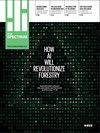过去向前第一台晶体管收音机
IF 2.6
4区 工程技术
Q2 ENGINEERING, ELECTRICAL & ELECTRONIC
引用次数: 0
摘要
1954 年 11 月 1 日,第一台晶体管收音机在商店上架,正赶上假日购物季。Regency TR-1 被宣传为世界上第一台袖珍收音机,尽管它的尺寸为 12.7 x 8.7 x 3.5 厘米,但它需要相当大的口袋--无论是字面上还是比喻上。这款收音机的售价为 49.95 美元,相当于现在的 580 多美元,巧合的是,你在 eBay 上买一台也就花了这么多钱。不过,这款收音机还是比任何真空管型号的收音机小得多。本文章由计算机程序翻译,如有差异,请以英文原文为准。
Past Forward: The First Transistor Radio
On 1 November 1954, the first transistor radio hit store shelves just in time for the holiday shopping season. The Regency TR-1 was advertised as the world's first pocket radio, although at 12.7 by 8.7 by 3.5 centimeters, it required pretty big pockets—literally and figuratively. The radio sold for US $49.95, or more than $580 today, which is coincidentally about what it'll cost you to buy one on eBay. Still, the radio was significantly smaller than any vacuum-tube model.
求助全文
通过发布文献求助,成功后即可免费获取论文全文。
去求助
来源期刊

IEEE Spectrum
工程技术-工程:电子与电气
CiteScore
2.50
自引率
0.00%
发文量
254
审稿时长
4-8 weeks
期刊介绍:
IEEE Spectrum Magazine, the flagship publication of the IEEE, explores the development, applications and implications of new technologies. It anticipates trends in engineering, science, and technology, and provides a forum for understanding, discussion and leadership in these areas.
IEEE Spectrum is the world''s leading engineering and scientific magazine. Read by over 300,000 engineers worldwide, Spectrum provides international coverage of all technical issues and advances in computers, communications, and electronics. Written in clear, concise language for the non-specialist, Spectrum''s high editorial standards and worldwide resources ensure technical accuracy and state-of-the-art relevance.
 求助内容:
求助内容: 应助结果提醒方式:
应助结果提醒方式:


